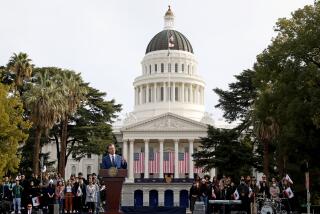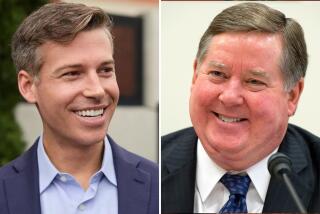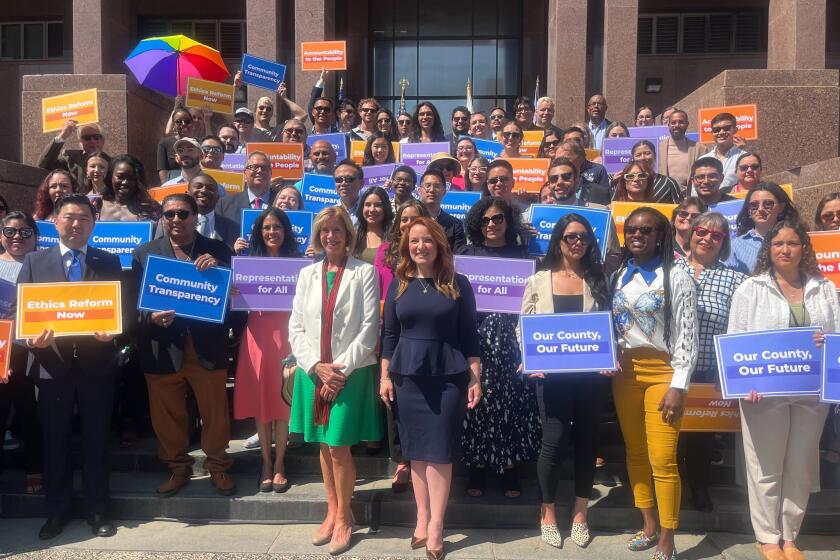Nonpartisan but Not Easy to Win : Despite campaign reforms, incumbents still usually triumph, runoff or not. But challengers have at least a chance to realize their dream.
- Share via
It’s tough to explain California’s local elections to people in most of the rest of the country. They have two political parties. We have none. They can go into a voting machine and pull one lever to vote for every candidate from the party of their choice. We must wade through page after page of a paper ballot.
When Hiram Johnson revolutionized California government, he removed political parties from local elections by having the state Constitution mandate that they be nonpartisan.
In a partisan race you capture the primary election by simply getting more votes than any other candidate in your party. Then there is a general election among the various parties’ winners.
In California, local candidates must get 50% plus one of the votes in the primary to be elected. If they get the magic number, there is no general election. So if you want to defeat an incumbent, the strategy is to force them into a runoff by encouraging a lot of candidates to run for the seat to try to keep the incumbent below 50%.
Three candidates or fewer running against an incumbent generally translates into an incumbent victory in the primary election. Five or more normally means a runoff. The trick for a challenger is to become the second-highest vote-getter.
The larger the field in a race for an open seat, the fewer votes you need to get into the general. In 1979, 16 candidates competed for an open seat in the 12th Council District. The top two vote-getters each had less than 25% of the vote. In a large field of relative unknowns, candidates with higher name identification going into the race or with a recognizable ballot designation have a leg up.
*
The system prompts pundits and the media to claim that incumbents forced into runoffs are in trouble. After all, a majority of the voters didn’t vote for them in the primary, did they? Well, yes, but . . .
In years in which there’s no mayor’s race, like this one, Los Angeles runoff elections tend to have very low turnouts. Runoff challengers rarely team up with the candidates who didn’t make it. Incumbents are most often reelected because they tend to have the money and organizational edge.
In the Valley, we’re looking at four council races this spring. Three incumbents are seeking reelection--in the 2nd District (part of North Hollywood through Sunland-Tujunga), the 4th (part of Studio City) and the 12th (the northwest Valley and northern Sylmar). The other is a special election for the unexpired term in the 5th District (Sherman Oaks).
The incumbents have all been through this exercise many times. By law, this will be the second-to-last time they can run. Their 1987 and 1991 races can be an instructive guide to this year’s probable outcomes:
1987: 2nd District, three challengers, Joel Wachs won in primary; 4th District, one challenger, John Ferraro won in primary; 12th District, one challenger, Hal Bernson won in primary.
1991: 2nd District, two challengers, Wachs won in primary; 4th District, one challenger, Ferraro won in primary; 12th District, five challengers, Bernson forced to runoff, won in general.
Even Bernson’s tough reelection fight in 1991 can be attributed not so much to issues as to three well-funded primary challengers with the ability to get their anti-incumbent message out.
*
This year should be different all around. None of the challengers to incumbents has shown any ability to raise the money necessary to pay for the mail required to spread their message. In the year-end dollar derby, none had raised any campaign funds. The next tally is due in two weeks. It will probably continue to show great disparities between incumbents and challengers. Pundits are likely to predict easy victories for all three councilmen.
Before you toss up your hands and exclaim, “There he goes, equating money with success in politics!” ponder the fact that in more than 90% of all elections the candidate with the most money wins.
The 5th District race, of course, is different from the other three. It’s an open seat. The Valley portion is less than half the district. Of the seven candidates, four have shown themselves to be contenders: Barbara Yaroslavsky, Lea Purwin D’Agostino, Howard Feuer and Roberta Weintraub. Each has shown some fund-raising and organizational ability. Each brings some “baggage” to the campaign. But political baggage generally denotes political experience. Yaroslavsky’s year-end financial report puts her ahead of any rival in fund raising by better than 2 to 1. D’Agostino has picked up the important police union endorsement.
Political wisdom would pick Yaroslavsky based on name identification and money. A lot can happen, however, between now and the two elections that will probably be needed to decide this district. Candidates’ mouths are often unguided muscles. Opponents are usually quick to capitalize on mistakes made by others. Front-runners can turn into also-rans very quickly.
*
So, what about the issues? There are basically three in all the contests: crime, earthquake response and, more generally, what the candidate has done for the voters lately. Has the trash been picked up, the trees trimmed, the potholes filled?
These issues will be punctuated by several initiatives on the April ballot. Wachs’ attempt to save money by allowing the city to buy from independent distributors is there. So is an attempt to change the City Charter to allow airport profits to be diverted to other uses. The previously defeated attempt to remove top administrators from the civil service resurfaces along with pension changes voters may find hard to swallow in the wake of Orange County’s problems.
The Greek philosopher Heraclitus, who said “change alone is unchanging,” would certainly be confused by Los Angeles politics. Despite dozens of reforms enacted in recent years, including campaign financing and term limits, incumbents win almost all of their races. In open-seat races, those with the most money and name identification usually win.
Why then would any of the unknown challengers run? That’s the beauty of our system. They all have at least an opportunity to realize their dream.
More to Read
Get the L.A. Times Politics newsletter
Deeply reported insights into legislation, politics and policy from Sacramento, Washington and beyond. In your inbox twice per week.
You may occasionally receive promotional content from the Los Angeles Times.









